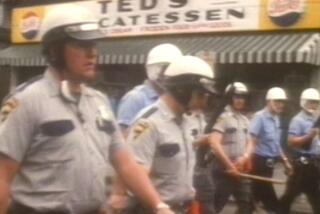The Strengths of John Ford, D. W. Griffith
- Share via
W. Griffith and John Ford may be the two American directors who’ve most determined how we view our country: its land and landmarks, places and people, the whole sweep and scope of its complex history. For all their alleged vices of sentimentality, chauvinism, oversimplification and melodrama, they are two nonpareil film artists as well. If they had recognizable flaws--Griffith’s racism and Ford’s militarism--they had many more strengths: of vision, of vigor and humanity, of virtuosic movie style.
Griffith’s 1924 “America”--showing Wednesday at Silent Movie (611 N. Fairfax; (213) 653-2389)--was his last great historical epic, a vast saga of the American Revolution, from first shot to Yorktown surrender, which includes a hair-raising re-creation of Paul Revere’s ride. It’s also the movie whose financial failure began his decline.
Ford’s “She Wore a Yellow Ribbon”--showing at UCLA’s Melnitz Theater tonight--was the sort of movie that destroyed Ford’s postwar credibility with “serious” critics: a cavalry Western starring John Wayne as crusty, retiring Col. Nathan Brittles, who, on his last days before retirement, guides a troubled command, fixes a tempestuous love triangle and helps his old friends, the Arapaho elders, avoid bloodshed. Back then--although Wayne won his first Oscar nomination as Brittles--”Yellow Ribbon” was seen as a potboiler. Today we see it as a Western poem, modeled on Frederic Remington’s images and lovingly crafted by a master. Information: (310)-206-FILM.
More to Read
Only good movies
Get the Indie Focus newsletter, Mark Olsen's weekly guide to the world of cinema.
You may occasionally receive promotional content from the Los Angeles Times.









